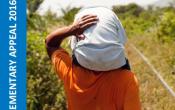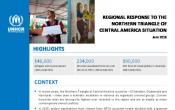Costa Rica
Operation: Costa Rica
Location
{"longitude":-84,"latitude":10,"zoom_level":7}
Latest update of camps and office locations 13 Jan 2016. By clicking on the icons on the map, additional information is displayed.
Key Figures
| 2015 end-year results | |
| 121 | survivors of SGBV received psychosocial and legal assistance |
| 16 | women assisted through local integration programmes |
| 2,203 | asylum claims processed in 2015 |
| 255% | increase in the refugee status recognition rate between 2014 and 2015 |
Latest Updates and Related Links
People of Concern
63%
Decrease in
2015
2015
| 2015 | 8,705 |
| 2014 | 23,718 |
| 2013 | 21,185 |

[["Refugees",3616],["Asylum-seekers",3283],["Stateless",1806]]
Loading ...
Budgets and Expenditure for Costa Rica
< Back
2015
{"categories":[2012,2013,2014,2015,2016],"budget":[2.83239045,2.05651441,2.88287074,3.028757242,4.78587632],"expenditure":[2.01193045,1.77834604,1.9659955,2.50565576,null]}
{"categories":[2012,2013,2014,2015,2016],"p1":[2.83239045,2.05651441,2.88287074,3.028757242,4.65387632],"p2":[null,null,null,null,0.132],"p3":[null,null,null,null,null],"p4":[null,null,null,null,null]}
{"categories":[2012,2013,2014,2015,2016],"p1":[2.01193045,1.77834604,1.9659955,2.50565576,null],"p2":[null,null,null,null,null],"p3":[null,null,null,null,null],"p4":[null,null,null,null,null]}
Loading ...
CHOOSE A YEAR
- 2015
Working environment
- Costa Rica has been hosting Colombian refugees located in urban areas for a long time. Although the influx of Colombian asylum-seekers remains in steady numbers, nationals from the northern triangle of Central America (NTCA) have surpassed the Colombian caseload, requiring a comprehensive re-thinking of UNHCR’s interventions as the profile of NTCA asylum-seekers includes significant changes from the Colombian profile.
- Both for the Colombian caseload and now crucially for the NTCA situation, Costa Rica remains a strategic protection space. Costa Rica stands as a country of asylum with a favourable legal framework.
- UNHCR’s comprehensive protection and durable solutions strategies, elaborated in coordination with the Government and other relevant actors, are focused on a two-pronged approach: enhancing refugee status determination (RSD) through the Quality Assurance Initiative (QAI) and facilitating local integration through the Graduation Model and Vivir la Integración (Living the Integration) programmes.
- Key tools such as the current Migration Law, the National Integration Plan and the recently-adopted Public Migratory Policy encourage the integration of migrants and refugees, which are now seen as vehicles for national development.
Population trends
- Costa Rica is facing a continuously increasing RSD caseload, as the country becomes more of a destination for refugees, as well as a transit country for those proceeding northward to seek asylum. According to national authorities, at year-end Costa Rica hosted some 3,616 recognised refugees and some 3,283 asylum-seekers.
- Most refugees and asylum-seekers came from the region; though the number of extra-continentals was on the rise. Some 62 per cent were Colombians (2,247 individuals), followed by Nicaraguans (452), Cubans (372), Salvadorians (203), Venezuelans (141), Hondurans (58), Guatemalans (22), Haitians (12) and extra-continentals (109).
- In 2015, some 2,203 asylum claims were processed, a significant 62 per cent increase compared to 2014. The refugee and asylum-seeker population was of mixed socio-economic origin. One in three asylum claimants in 2015 were minors. Costa Rica also hosts a considerable number of persons born in the country to foreign parents – mainly Nicaraguan and Panamanian Ngöbe Buglé, indigenous transnational workers at risk of statelessness. The number of persons with an undetermined nationality at year-end was as high as 1,806.
Achievements and impact
- Immediate access to RSD procedures resulted in no cases of refoulement. Recognition rates presented a substantial increase of 255 per cent compared to 2014.
- Protection of children: The UNHCR/UNICEF/Supreme Electoral Tribunal joint Chiriticos’ project assisted some 1,394 persons in their certification of nationality, late birth registration and documentation procedures, ensuring effective access to fundamental rights and essential services.
- Self-reliance and livelihoods: The Graduation Model has assisted a cumulative number of 450 participants. 90 of those started their own business and 70 are in the process of doing so. 118 of them have graduated, becoming self-reliant. 160 persons have found employment through the corporate social responsibility scheme (CSR) Vivir la Integración programme.
- A Memorandum of Understanding (MoU) was signed with the Presidential Social Council and the Migration Directorate to include PoC into national development, poverty reduction, entrepreneurship and employment programmes.
- An MoU was signed with the Ministry of Education, which ensures the full enjoyment of the right to education and facilitates the validation of study titles held in the country of origin.
- The Graduation Model programme was included in the National Development Plan 2015-2018.
- An agreement with the National Institute of Learning was ratified that guarantees equal access to technical training and certification of capacities for refugees.
- The Costa Rican Chamber of Commerce, which is comprised by more than 800 companies, joined the CSR scheme, together with the already existing partner Business Association for Development (AED), comprising more than 120 companies, representing a significant amount of potential employers for PoC in the country.
Unmet needs
- Even though access to education was granted by law, barriers to effectively access the educational system prevailed in 2015. Due to a funding shortfall, only 50 families were supported with school packages, including uniforms and school supplies.
- A new wave of asylum-seekers arrived to the country in 2015, notably from the Central American region, whose socio-economic profile and needs responded to a different protection context and required further assistance.






